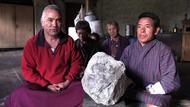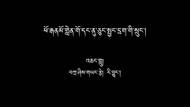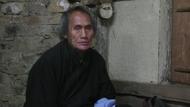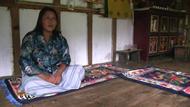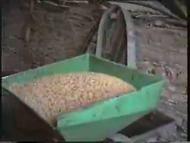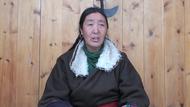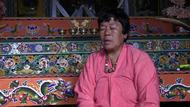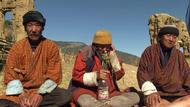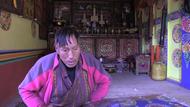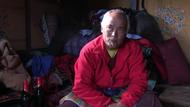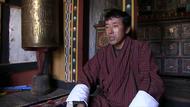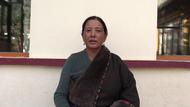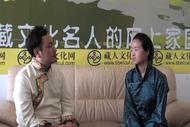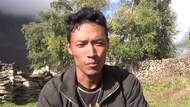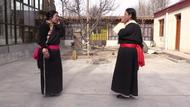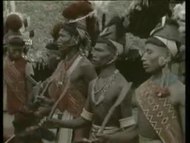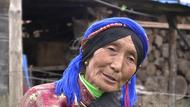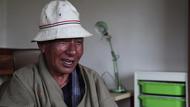Video Overview
This title demonstrates the process of carving wood blocks for traditional book printing at the Degé Printing House.
- Kham
- Degé Publishing House
- Speaker 1ད་ལྟ་སྡེ་དགེ་དཔར་ཁང་དུ་དེང་རབས་ཅན་ཟེར་ན། དཔར་གསར་པ་རྐོས་བ་རྣམས་དང་། སྔོན་མ་ཅན་ཟེར་ན་ཉམས་སོང་བ་དག་ཉམས་སོང་བྱས་པ་དང་།Now there are many printing woodblocks made in Dege Printing House, they are either modern woodblock which are newly made or older ones which have been renovated.
- Speaker 1དེ་མིན་སྒྲོལ་ཟམ་ཐེབས་རྩ་ཚོགས་པའི་རོགས་རམ་འོག་རྐོས་པའི་ཤིང་མཆོག་ཀ་པ་ལྟར་དཔར་གསར་པ་དེ་དཔར་ཁང་དུ་མང་པོ་ཞིག་རྐོ་བཞིན་ཡོད་རེད།With help from the Bridge Fund, we have been making lots of new printing woodblocks like shing mchog ka pa.
- Speaker 1ཡིན་ནའང་། རྐོ་བའི་རྒྱུ་རྐྱེན་དེ་ཟེར་དགོས་ན་ནི། གཙོ་ཆེ་བ་དཔར་རྐོ་ས་ཤིང་ང་ཚོ་བོད་ཁམས་སུ་ཡོད་ཤིང་འཁྲིས་པ་ཟེར་བ་དེ་རེད། དེ་ཡོད་ལུ་རེད། ཡོད་རྒྱུ་དེ་སྡེ་དགེ་ས་རུ་ཉུང་ཉུང་ཡོད་ལུ་རེད།However, the reason why we make new woodblocks is that there is less and less carving woods in dege areas, which is called Treepa in Tibetan.
- Speaker 1ད་ལྟ་ཕལ་ཆེར་སྡེ་དགེ་ས་ཁོངས་ནས་དཔར་ཁང་སྒོ་ཕྱེ་ནས་རིན་ཆེན་གཏེར་མཛོད་ལ་སོགས་པ་དཔར་གདན་ཧ་ལམ་ཁྲི་ལྔ་དྲུག་དྲུག་བདུན་ཞིག་རྐོས་ཚར་བས། སྡེ་དགེ་ཕྱོགས་སུ་ཡོད་པའི་ཤིང་དེ་ཕལ་ཆེར་འཐུ་ཚར་འགྲོ་ཡོད། ཤིང་དཀོན་པོ་འདྲ་ཆགས་ཡོད།Since the Dege Printing house was opened, we have made about five to seven thousand woodblocks such as Rinchen Terdzo, therefore this kind of wood in Dege is almost gone and very rare.
- Speaker 1དེ་ནས་ན་ནིང་གཞེས་ནིང་ལོ་ཁ་ཤས་ཀྱི་སྔོན་ནས་བཟུང་ཕར་འཇོ་མད་ལ་འབྲེལ་བཟོས་ནས་ཤིང་འཐུ་རྒྱུ་དང་། མར་དཔལ་ཡུལ་ལ་འབྲེལ་བ་བཟོས་ནས་ཤིང་འཐུ་སོགས་ས་གཞན་པ་ནས་ཤིང་དེ་ཚུར་ཨེ་རག་བལྟས་ནས་ཚུར་ཁྱེར་ཡོང་བ།So during the last two years, we tried to get a connection up in Joda and down in Palyul or other places from which to import the wood.
- Speaker 1ཚུར་ཁུར་ཡོང་ནས་དྲ། དྲས་ཚུར་ནས་གཞོག དཔར་ཡིག་བཏབ། དེ་ལ་འབུར་ལེན་རྒྱབ་ཁྲིག་ཁྲིག་བཟོས་ནས།[After wood is imported here, we cut them and shave, measure, smooth and get them ready.
- Speaker 1དེ་ནས་སྐམ་སོ་རྩིག་ལུགས་ལ་གཅིག་ན་སྐམ་སོ་རྩིག་ལུགས་ལ་ཡག་པོར་རྩིག་དགོས་པ། གཉིས་ཉི་མ་ནང་སྐམ་ན་གས་འགྲོ་བ་སོགས། གྲིབ་མའི་ནང་དང་རླུང་འདྲ་ཅུང་ཙམ་ཕོག་ས་ལ་བཞག་དགོས་ནས་ཁ་ཁ་བྱས་ནས་བརྩིགས།As for how you build the woods to dry, first you should build the woods well and second you shouldn’t dry in the sun, otherwise it will be cracked, instead dry in shade and get some wind.
- Speaker 1དེ་ནས་སྐམ་ཚར་རྗེས་ཡང་གཞོག་ཅིག་བཟོས་བ་སྟེ། འབུར་ལེན་ཡང་རྒྱག་ཅིག་བྱས་ནས་འཇམ་པོ་བཟོས། དེ་འདྲ་བྱས་ནས་དཔར་རྐོ་ས་དེ་འདྲ་རེད།After it gets dry, you need to shave one more time, and smooth as well. This is how you get the wood ready for carving.
- Speaker 1ཤིང་འདི་ཡོང་ས་ནི་གཙོ་ཆེ་བ་འདྲ་ནི་སྡེ་དགེ། དཔལ་ཡུལ། འཇོ་མདའ། ཐག་རིང་ས་ཡིན་ན་བོད་ལྗོངས་པ་ཡིབ། སྤྲ་མོགMost of these woods are from dege, palyul, Joda, even far from Bayab and Trimog in the TAR.
- Speaker 1ད་དེ་འདྲ་བྱས་ནས་ད་ལྟ་དཔར་ཁང་གི་ཤིང་། སྔོན་མ་དཔར་ཁང་ཚང་གི་ལྷ་གསར་པརྐོ་ཡོང་མཁན་དེ་ཚོས་དཔར་ཤིང་ཕལ་ཆེར་དེ་བོད་ལྗོངས་གྲོ་མོ་ནས་མར་ཁུར་ཡོང་བ།
- Speaker 1དེ་བཟོ་ན་མ་གཏོགས། ད་ལྟ་འདྲ་ཡིན་ན་དཔར་ཤིང་དེ་འདྲ་ཡག་མོ། ཞེང་ཆེ་བ་ད་ང་ཚོ་སྡེ་དགེ་ས་ཡོད་བཞིན་མི་མགུ་ལོ།
- Speaker 1ད་ལྟ་ཕར་ཕར་སོང་ན། ཤིང་དེ་ཆེས་དཀོན་དཀོན། རྐོ་ས་དེ་དང་ཐག་ཇེ་རིང་རིང་རེད།Otherwise there is no wood and wide wood in Gege nowadays, those who carved deities here in Parkhang before imported most of the wood from Trimog. In the future, the wood will be less and less and further and further from the woods.
- Speaker 1ད་ལྟ་དཔར་རྒྱ་ཆེ་ལ་ལ་ཞིག་རྐོས་ན་ཡང་མིན་ན་ཡར་བོད་ལྗོངས་ལ་འབྲེལ་བ་བཟོས་ནས་གཅིག་ནི་སྤྲ་མོག། མིན་ན་དཔལ་ཡུལ་འདྲ་ལ་འབྲེལ་བ་མ་བཟོས་ན། ཤིང་མང་པོ་ཞིག་བླངས་དགོས་ཅུང་ཙམ་ལེན་དཀའ་བ་འདྲ།So today if you make a little wider woodblock, you need to contact either further into the TAR for Trimog or to Bayab, otherwise it already became difficult to get large amount of wood.
- Speaker 1དེ་ན་ནིང་ང་ཚོས་མར་འཇང་ཡུལ་ལ་འབྲེལ་བ་ཞིག་བྱས་པ་ཡིན། འཇང་ཡུལ་ལ་ཤིང་འཁྲུས་པ་རྗེས་སེ་རྗེས་སེ་ཡོད་རེད།We contacted with Jang Yul (Dechen) last year, there is some Treepa wood in Jangyul.
- Speaker 1ཡིན་ནའང་། ལམ་ཐག་གཅིག་རིང་། ད་དངོས་ནས་རིན་གོང་ཆེན་པོ་མ་ཤོར་རུང་། ལམ་ཡར་ལ་ཁུར་གླ་བརྡ་གླ་ཟེར་དགོས་ན་དེ་ལ་སོགས་པ་ཤིང་དེར་འགྲོ་སོང་ཆེན་པོ་འགྲོ་མགུ་སེམས་སེམས་ཤིག་རེད།However, it’s very far and secondly it’s very expensive to ship the wood up here etc. In all it’s too expensive to get wood from there.
- Speaker 1ད་མ་རྩ་ཤིང་དེ་འཐུ་རྒྱུ་ཡོད་ས་དང་འཐུ་ལུགས་སྤྱོད་ལུགས་དེ་འདྲ་རེད།That’s all speaking of where you get the wood and how you get it.
- Speaker 1དེ་ནས་དེར་དཔར་ག་འདྲ་རྐོས་ན་དཔར་ཚགས་ཟེར་བ་འབྲི་རྒྱུ་ནི་ལག་པ་རང་གིས་བྲིས་ནས་མ་དཔེ་ལ་བལྟས་ནས་བྲིས།བྲིས་ཚར་དུས་ཤིང་གི་ངོས་ལ་སྦྱོར། སྦྱར་ནས་དཔར་རྐོ་མི་ཡིས་རེ་རེ་བཞིན་རྐོ་དགོས་པ་རེད།ད་དེ་འདྲ་བཟོས་ནས་དཔར་གདན་རེ་རེ་བཞིན་དུ་རྐོ་དགོས་རེད།Whatever printing you need to carve, first you need to write the Partsak (the scripture written paper) by hand based on original scripture, and then glue it on the wood, the carver will carve out the letters one by one.
- Speaker 2ཁ་ཕ་སྐོར་དགོས་ལུ་ཡེ་རེད།Do you need to put it inwards?
- Speaker 3ཨན་ཨན།ཕ་ཕྱིར་ཁ་སྐོར་དགོས་རེད། ཚུར་དོད་ཡོང་རེད།Yes, you need to put it inwards.
- Speaker 2ད་དཔར་ཚགས་ཕར་སྦྱོར་ཚར་ནས་སྐོམ་ཚར་དུས་རྐོས་ན་རེད་ནི་ཨེ་རེད།Then you need to glue the Partsak toward inwards, and when it's dry you can carve, right?
- Speaker 3ད་སྐམ་ཚར་ནས་ཡང་འབྱིད་དགོས་རེད། ཤོག་བུ་འདི་ཚུར་འབྱིད་དགོས་རེད། སྣག་ཚ་འདི་ཤིང་ལ་ཕར་འཐིབ་འགྲོ་དུས།Hmm, yes. When it gets dry, you need to rub the paper away. When the paper got rubbed away, the ink will sink into the wood.
- Speaker 3ཤོག་ལེབ་ཚུར་ལ་དཀོག་དགོས་ནི་ཨེ་རེད།Do you need to rub the paper away?
- Speaker 3ཨན་ཨན།Hmm, yes.
- Speaker 3དཔར་ཚགས་ཕར་སྦྱོར་ཚར་ནས་སྐོམ་ཚར་དུས་དེ་ནས་ཚུར་་་་་་Glue the Partsak inwards and dry it , then...
- Speaker 3ཤོག་བུ་སྲབ་མོ་ཡོད་ན་འབྱིད་སླ་མོ་སྐྲག་མོ་ཡོད་རེད། ཤོག་བུ་མཐུག་པོ་ཡོད་ན་འབྱིད་དཀའ་མོ་སྐྲག་མོ་ཡོད་རེད།If the paper is thin, it’s very easy to rub and if it’s thick then it is difficult to rub away.
- Speaker 3ད་རྐོ་རན་རེད།Speaker 2 Now it's ready to carve.
- Speaker 3ཡ།I see.
- Speaker 1ད་དེ་རྐོས་ཚར་རྗེས། གཅིག་བསྡུར། མ་དཔེ་དང་ད་ལྟ་གསར་པ་རྐོས་ཟིན་པའི་བུ་དཔེ་ཟེར་བ་དེ་གཉིེས་ཐོད་གཏུགས་ནས་དག་ཡོད་མེད་དང་ཆད་ལྷག་ཡོད་པ་ཨེ་མགུ་བལྟས་ནས་་ནོར་ཡོལ་འཁྱུགས་གསུམ་ཡོད་མེད་བལྟས་ནས་ཞུ་དག་ཟེར་བ། ཞུ་དག་ཟེར་བ་ཐེངས་གཅིག་གཉིས་གསུམ་ཕལ་ཆེར་ཐེངས་གསུམ་དང་ལྔ་བར་མ་བཟོས་ན་ཕལ་ཆེར་དག་མོའམ་ཡག་མོ་ཞིག་ཡོང་དགོས་ན་དཀའ་མོ་ཡོད་ས་རེད།When you finish carving, you need to compare one more time, the original text and the woodblock you just carved are put together to check if there is any mistake or omission and addition or carved crooked etc. Proof read 3 to 5 times, otherwise it’s hard to be correct and look nice.
- Speaker 1དཔར་རྐོ་མཁན་ནང་ལའང་ད་ཟེར་རྒྱུ་ནི་མེད་པར་ལག་རྩལ་ལ་ལ་ལར་ལག་རྩལ་ཡག་མོ་ཡོད་པ་དང་། ལ་ལའི་ལག་རྩལ་ཞན་པ་སོགས་ཡོད་པས། རྐོ་རྒྱུ་ལའང་རྫི་སེ་རེད་མ་རེད་དང་ཆད་ལྷག་སོང་བ་དེ་འདྲའི་ཕྱོགས།As we all know there is of course difference among the artisans and their skills. Some have good skills but some don’t therefore there may be some mistakes or omission and additions.
- Speaker 1ཕྱོགས་ཚང་མ་ནས། ཐེངས་གཅིག་ལྟ་གཉིས་ལྟ་གསུམ་ལྟ་བཞི་ལྟ་ལྔ་ལྟ་ཐེངས་མང་པོ་ཞིག་བལྟས་ན། དེའི་ཐོག་དང་པོ་དཔེ་ཆ་མཁས་པ་ཞིག་དཔེ་ཆ་ཡག་པོ་ཤེས་མཁན་ཞིག་ལ་ལྟ་བཅུགAfter checking three to five times all aspects, a good scholar or someone who can read the scripture well check it one more time.
- Speaker 1བཅོས་ཚར་བ་དེ་ཚུར་ཁུར་ཡོང་ནས་ད་རྐོ་བཅོས་ཟེར་ནི་དཔར་ཐོག་བལྟས་ནས་ནོར་ཡོད་ནི་ཚང་མ་བཅོས། ནག་པོར་ལྷག་བསྡད་ཟི་ཡོད་ན་ཚུར་རྐོས་ནས་ནང་ཤིང་ཚགས་གདབ་ནས་དེའི་ནང་ཡིག་འབྲི་ཇི་མ་ཇི་བཞིན་ཚུར་རྐོས།Then bring it back and re-edit it in a process called Kojoe or sko bcos (correct carving) by correcting all the mistakes that are found. If there are some parts that are too dark to print out syllables clear, you need to put wood ash in and carve each syllable very clearly.
- Speaker 1ད་དེ་འདྲ་བྱས་ན་དཔར་རྐོ་ལུགས་རྐོ་ཚུལ་དེ་འདྲ་རེད།This is how you carve the woodblock.
- Speaker 1དེ་ནས་ཞུ་དག་དང་རྐོ་བཅོས་གཉིས་ཀ་ཚར་རྗེས་སྣུམ་བྱུག ཕལ་ཆེར་དཔར་ལེབ་རེ་ལ་མར་རྒྱ་མ་སྲང་དོ་རེ་ཙམ་འགྲོ་ས་རེད། དེ་བཞིན་དཔར་ལེབ་རིམ་པ་བཞིན་དཔར་ལེབ་ཚང་མར་སྣུམ་རྒྱག་ནས་སྣུམ་ཉི་མར་གདིང་ནས་སྣུམ་འཐུང་བ་བྱས་བཅུག། སྣུམ་འཐུང་ཚར་རྗེས་ཡང་ཆུ་ལ་ཅིག་འཁྲུ། ཆུ་ལུ་བཀྲུས་ཚར་དུས་ཡང་དཔར་ཅིག་རྒྱག དེ་ནས་སྔོན་མ་རྐོ་བཅོས་བྱས་ཟིན་ནམ་ཞུ་དག་བྱས་པ་དེ་ཚང་མ་ཡག་པོ་ཡོད་མེད་ཡང་དུ་གཅིག་ལྟ།After you finish both proof reading and correcting the carving, you need to apply some cream or oil onto it, approximately one piece of woodblock needs two sangs (50g) of melted butter. After applying oil to all the pieces, dry it in the sun and let all the oil absorb completely. When the oil is soaked in, wash in water once and print it again and check if all the corrections are well done or not.
- Speaker 1དེ་ནས་ཡང་དུ་ལྟ་ཡོང་དུས་ད་དུང་ཆད་ཡོད་ན་གྲུག་ཡོད་ན་དེ་ནས་རྐོ་བཅོས་ཡང་གཅིག་བྱས། དེ་འདྲ་མུ་མཐུད་ནས། ད་དཔར་ལུགས་ཀྱི་གོ་རིམ་འདྲ་ཟེར་དགོས་ན་དེ་འདྲ་ཞིག་འགྲོ་དགོས་རེད།If there are still mistakes you need to re-correct the carving once more and continue that until everything is good. This is the procedure of how you carve woodblocks.
- Speaker 1དེ་ནས་ཞིབ་ཆ་བཟོ་དགོས་རྒྱུ་དང་སྤུས་ཀ་སྲ་ཞན། རྐོ་ལུགས་ལ་ད་ཚང་མ་ཡོངས་མས་ལག་ཤེས་ལ་སྤུས་བཟང་ཞིག་བཟོས་ཡོད་རོགས་ཟེར་བ་ལྟར། ད་ལྟ་ང་ཚོས་པར་ཁང་ཚང་གི་དཔར་རྐོ་མཁན་གདན་རྒྱུ་གཙོ་ཆེ་བ་བོད་ལྗོངས་འཇོ་མདའ་རྫོང་གི་ཁ་ཞབས་སུ་སྐུ་སེ་རུ་བ་ཟེར་བ།དེ་སྤྱི་ཚོགས་གསར་རྙིང་གཉིས་ཀྱི་སྐབས་སུ་པར་རྐོ་མཁན་ཕར་ཆེར་སྐུ་སེ་དང་སྤོ་ལུ་འདི་གཉིས་ནས་མི་དེ་རྙེད་རེད།As everyone expects, for more attention to detai, quality of carving and better qualified craftsmen, we invite carvers mostly from Kuse, Joda, and the TAR. Most of the carvers were from Kuse and Polo in the old days and this is the same today.
- Speaker 1ཁོ་ཚོ་ལ་དང་ནས་ལག་ཤེས་དེ་རྒྱུན་མ་ཆད་པར་ཡོད་པས་ཁ་རུང་གི་མི་གཞན་དང་མ་འདྲ་བར་ལག་ཤེས་ཡག་ཤོས་དང་རྐོས་བ་དེ་ཚོའི་སྤུས་ཀ་ཡག་ཤོས་རེད། དེ་བས། ང་ཚོར་དུས་རྒྱུན་དུ་རྐོ་མཁན་ལ་སྡེ་དགེའི་མི་ཁ་ཤས་མ་གཏོགས་མང་ཆེ་ཤོས་འཇོ་མདའ་སྐུ་སེ་ཡི་མི་ལ་རྐོ་བཅུག་བཞིན་ཡོད་རེད།They, unlike others, have an unbroken legacy from their predecessors, so they have the best skills and the most qualified carvers. Therefore, we usually have carvers from Kuse, Joda carve with a few from Dege.
- Speaker 1ད་དཔར་རྐོ་ལུགས་རྐོ་སྟངས་དེ་འདྲ་རེད།That’s about how you carve woodblocks.
 Loading ...
Loading ... 




